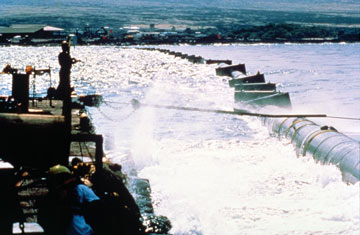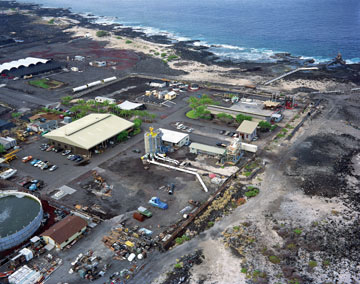|
TRENDS & INNOVATIONS
Resuscitating Ocean Thermal Energy
 Courtesy of DOE/NREL, Credit – A. Resnick, - Makai Ocean Engineering, Inc. |
| A crew installs the cold water pipe for the ocean thermal plant at the Natural Energy Laboratory of Hawaii Authority. |
Imagine a power plant that generates a never-ending supply of electricity around the clock without emitting any carbon dioxide. Now imagine that plant also produces freshwater, provides nutrients for aquaculture and transforms seawater into hydrogen that can be used for fuel. This may sound like science fiction, but it’s not. It is ocean thermal energy conversion. And researchers are working to bring this form of renewable energy to tropical locations such as Puerto Rico. It could happen in a few short years, they say, pushing ocean thermal one step closer toward playing a role in satisfying the energy needs of people all around the world.
The oceans store solar energy as heat. Ocean thermal energy conversion takes advantage of this by using the temperature difference between the warm surface water and cold deepwater to generate electricity. In an ocean thermal plant, warm surface water is first pumped through a heat exchanger where it boils ammonia (which has such a low boiling point that the warm water can vaporize it without additional heat). Pressure from the evaporated ammonia turns a turbine, which in turn spins a generator. The evaporated ammonia flows into another heat exchanger where it is condensed by icy water pumped up from the depths of the ocean. The liquid ammonia then returns to the first exchanger to begin the cycle once again.
The idea is not new. In fact, ocean thermal does have its roots in science fiction. The concept first made an appearance in Jules Verne’s 1870 novel Twenty Thousand Leagues Under the Sea. But the United States didn’t begin to investigate its potential until a century later, when the country faced a major energy crisis. At that time, the United States established research programs to develop several types of renewable energies. In 1974, the Department of Energy (DOE) took control of the ocean energy program. The United States envisioned having 100 ocean thermal plants up and running by 2000, and spent $250 million to make it happen.
But when President Reagan entered the White House and oil prices began to drop, interest in renewables disappeared and so did the government’s enthusiasm for ocean thermal. “Although Reagan tried to reduce funding for all six renewable energy research and development programs, he singled out one of them — ocean thermal — for elimination,” says Robert Cohen, the first manager of the U.S. ocean energy program. By 1995, after years of ever-deeper spending cuts, DOE stopped funding ocean energy research. “It’s potentially the biggest renewable energy option out there,” Cohen says, “and we have been turning our back on it.”
Now the United States is again in the middle of an energy crisis with oil prices at an all-time high and climbing. But today there’s also the added pressure of worrying about how to stave off the negative effects of global warming. So the few researchers who worked on ocean thermal during its heyday and hung on through the tough times of the 1980s and 1990s are trying to revive the concept and finally make it a reality. The question now is how to move forward. “We know how to do it,” says research engineer Gerard Nihous of the Hawaii Natural Energy Institute at the University of Hawaii at Manoa, who worked on ocean thermal from 1983 to 1997. “It’s a matter of doing it in a way that makes sense.”
 DoD photo by Senior Airman Rebeca M. Luquin, U.S. Air Force |
| The U.S. Navy is contracting to build an ocean thermal plant on the island of Diego Garcia that would provide the military base there with all of its electricity and freshwater. |
For Thomas Plocek, president of Offshore Infrastructure Associates, moving forward means escaping from what he calls the “Valley of Death” — the purgatory between proving a technology works and proving it can be commercially successful. In 1979, Hawaii partnered with several companies, including the Lockheed Missiles and Space Company, to show that ocean thermal could work by converting an old barge into a floating ocean thermal plant that generated a net of about 15 kilowatts of electricity. By 1993, the Natural Energy Laboratory of Hawaii Authority (NELHA) had constructed a land-based plant on the west coast of Hawaii’s Big Island, where the deep ocean water was transported through pipes onshore to produce 210 kilowatts of net power. But ocean thermal funding dried up before anyone had the chance to build a commercial-scale test plant, says Jan War, NELHA’s operations manager.
Currently, Plocek’s company is negotiating with the Puerto Rico Electric Power Authority to supply electricity to the island. If successful, Plocek will build the first commercial-scale ocean thermal plant: a 75-megawatt facility seven kilometers off Puerto Rico’s southeast coast. But it won’t be cheap. Plocek estimates that it will cost about $600 million, although he says the price tag for future ocean thermal plants should go down once the manufacturing process becomes more streamlined.
Even at $600 million, the plant could be profitable, Plocek says. Once a plant is paid for, he notes, there’s no fuel cost — warm ocean water is free. In the past, ocean thermal was criticized for its high capital costs. But that was before oil hit $100 per barrel. Now “all economic calculations of the past are invalid,” Nihous says. Because Puerto Rico and other island states predominantly use oil to generate electricity, their electricity costs are increasing quickly, making other energy forms cheaper by comparison. A 75-megawatt ocean thermal plant, for example, would save Puerto Rico at least 1 million barrels of oil annually, Plocek says. By selling electricity at about 13 cents per kilowatt-hour, Plocek says his investors will see a return on their money. Additional money can be made by configuring the plant to desalinize some of the seawater and pumping the deep cold water to a land-based plant where the nutrient-rich water can foster aquaculture.
Hans Krock, founder of Ocean Engineering and Energy Systems, also thinks ocean thermal is ready. His company is in talks with the U.S. Navy about installing a 13-megawatt ocean thermal plant on Diego Garcia, an equatorial island in the Indian Ocean that’s home to a U.S. military base. Krock says he’s “very close” to reaching a power purchase agreement, which is dependent on the company raising enough money to build the plant. The plant would not only provide the base with all of its electricity, it also would provide it with all of its freshwater.
 courtesy of DOE/NREL, Credit - Warren Gretz |
| The Natural Energy Laboratory of Hawaii Authority is home to a land-based ocean thermal plant. |
Building the first large-scale ocean thermal plants shouldn’t be much different from building the smaller ones, Krock says. “Every bit of the technology exists,” he says. But others disagree. “Quite frankly, no one has done ocean thermal on a commercial scale,” War says. “Going to 75 megawatts would be a big undertaking.” One problem, he says, is designing a cold water pipe large enough to pump up enough deepwater to keep the plant going.
Ocean thermal should follow a more measured path forward, War says. NEHLA intends to build a 1-megawatt plant that he says will demonstrate ocean thermal’s viability at a larger scale. Sometime later this month or in July, NEHLA will seek competitive bids from companies interested in constructing the plant.
Things could progress even faster if the federal government resumed funding ocean thermal, Cohen says. Cohen lobbied Congress in 2007 to restore DOE’s dormant ocean energy program. But geopolitics makes ocean thermal a hard sell, Nihous says. At the moment, the energy source will only directly benefit tropical islands, located in equatorial waters where ocean temperature differences are large enough to efficiently fuel an ocean thermal plant. Ocean depths tend to drop off pretty quickly near these islands, so access to the necessary deep cold water is close by. That’s important because it’s not yet economically feasible to transport the electricity long distances through submarine electrical cables. So even though the Gulf Coast, for example, is home to the proper temperature differences, these conditions exist at least 95 kilometers offshore (compared to just a few kilometers off Puerto Rico).
Nevertheless, in the long term, even countries at higher latitudes may have a lot to gain. Instead of producing electricity to power homes, floating ocean thermal “plantships” located in tropical and subtropical waters could use the electricity they generate to break down seawater into hydrogen or to produce ammonia, which can then be packed on cargo ships and sent anywhere in the world to be used as fuels for cars, fertilizer or to be burned for electricity. China is already considering these prospects, Krock says.
Lockheed Martin is also “assessing the market potential for ocean thermal-generated power,” says Jack Papp, a spokesman for Lockheed Martin MS2 Undersea Systems in Manassas, Va. The company is working with Makai Ocean Engineering, which won a grant from the Office of Naval Research to investigate the potential of ocean thermal to produce hydrogen. “The fact that such a large company has recently resumed its interest in ocean thermal is an encouraging sign for the future,” Cohen says.
Once ocean thermal can get over its initial hurdle, things will be full-steam ahead, Plocek says. “Once the first one is demonstrated, we won’t be able to keep up with demand.” Krock shares that outlook. “People are reluctant to invest” in the first ocean thermal plant, he says, but there are “15 other projects that want to be second.”

 Subscribe
Subscribe


